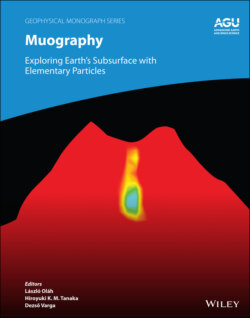Читать книгу Muography - Группа авторов - Страница 19
1.2.4 Seasonal Atmospheric Effect in the Muon Flux
ОглавлениеWhen the time‐sequential muographic images are evaluated, it is necessary to consider the daily and seasonal variations in the muon flux. These variations are mainly caused by the spatio‐temporal variations in the interplanetary magnetic field (IMF) and the atmospheric temperature, and affect the entire energy range of the muon spectrum. Anisotropies of the IMF are related to the solar activities (11‐year and 22‐year solar cycles and large‐scale bursts of plasma and magnetic field, such as coronal mass ejections [CME]). The 11‐year and 22‐year solar cycles affect the sub‐GeV energy region of the cosmic‐ray muons, and variations of the muon flux due to this effect are small (a few percent) (de Mendonca et al., 2016). The CME also affects only the sub‐GeV energy region, but the muon flux (E > 100 MeV) can be periodically changed by 10% within a few days (Augusto et al., 2012).
The temperature variations cause barometric (tropospheric pressure) variations, and thus affect the muon count rate. Therefore, the muon count rate shows a negative temperature correlation within a day. Since daily barometric variations are generally less than one percent in the mid‐latitude region, the corresponding muon flux variations are up to a few percent. For example, the daily flux variations measured at 44o 21′N, 76 m a.s.l. was ± 2.5% for muons with energies above 0.4 GeV; this corresponds to the muon range of 200 g/cm2 in rock (Saftoiu et al., 2010).
A major contributor to the seasonal variations in muon flux is not only the tropospheric but also the stratospheric temperature (or pressure) variations. While the tropospheric temperature variations affect low‐energy muons, the stratospheric temperature variations affect high‐energy muons. The temperature variations in the stratosphere, where the mesons are copiously produced, change the MFP of the meson‐nucleon interactions in the stratosphere. As a consequence, high‐energy muons have a positive stratospheric temperature correlation. The Daya‐Bay detectors were located underground at three different depths (ranging from 250–860 hg/cm2) and recorded the seasonal variations in muon flux at each depth (Daya Bay Collaboration, 2018). There was a tendency for the seasonal variations to be more enhanced for deeper detectors: 0.5% at a depth of 250 hg/cm2 and 1% at a depth of 860 hg/cm2. At a deeper site (3,800 hg/cm2), stronger variations (~3%) were observed (Borexino Collaboration, 2019).
In conclusion, muographers have to consider the following two factors when they conduct the time‐dependent measurements: (i) The stratospheric effect in high‐energy muons must be considered. However, currently, there are no experimental data for the horizontal muons. Such data will be necessary in the near future. (ii) When muographers need to normalize the time‐sequential muographic data to the open‐sky muon count rate for the purpose of cancellation of the factors originated in the detector configuration, such as geometrical acceptance, efficiency, etc., the spatial scale of the target objects and the timescale of the measurements have to be well considered so that the aforementioned geomagnetic and atmospheric effects become negligible in their measurements.
